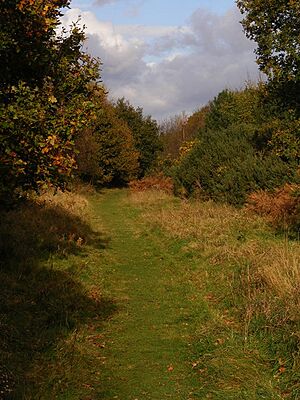Dunwich Forest facts for kids
Dunwich Forest is a beautiful area of trees and open land called lowland heath. It's located about 1.6 kilometers (1 mile) northeast of the village of Dunwich in Suffolk, England. This forest covers about 9 square kilometers (3.5 square miles). It was first planted by the Forestry Commission, a group that manages forests in the UK.
Dunwich Forest is part of the Suffolk Coast and Heaths Area of Outstanding Natural Beauty. This means it's a special place with amazing landscapes. It's also in an area known as the Suffolk Sandlings. Close by, you can find Dunwich Heath, managed by the National Trust. This heath is one of the biggest areas of lowland heath left on the Suffolk coast. The famous Minsmere bird reserve is also nearby. To the north and east, you'll find Dingle Marshes, which are part of the Suffolk Coast National Nature Reserve.
How Dunwich Forest Was Made
The Forestry Commission bought land from the Dunwich and Westleton areas in the 1920s. After getting this land, they started a big project to plant many trees. They mostly planted conifer trees, which are trees like pines and firs that stay green all year. This is how Dunwich Forest began. Today, the forest has a mix of these conifer trees and also broad-leaved trees, which lose their leaves in autumn. There are also some open areas of heathland.
Bringing Nature Back: The Rewilding Project
Since 2006, the Forestry Commission has been working on an exciting project called "rewilding" at Dunwich. Rewilding means helping nature return to a wilder state. They are working with the Suffolk Wildlife Trust and the Royal Society for the Protection of Birds (RSPB).
Their plan is to slowly replace the conifer trees in the northern part of the forest with broad-leaved trees. They also want to change areas in the south of the forest back into lowland heath. Lowland heath is a very rare habitat in Britain, so this project is super important for wildlife. To help with this, the Suffolk Wildlife Trust has brought Dartmoor ponies to the northern area. These ponies help manage the land by grazing, which keeps the heath healthy. This part of the forest managed by the Suffolk Wildlife Trust is about 270 hectares (670 acres) in size.
Images for kids



